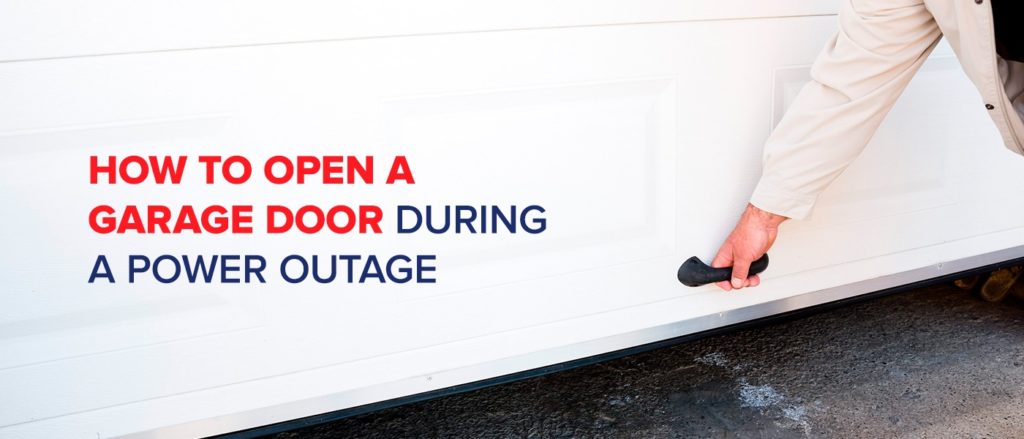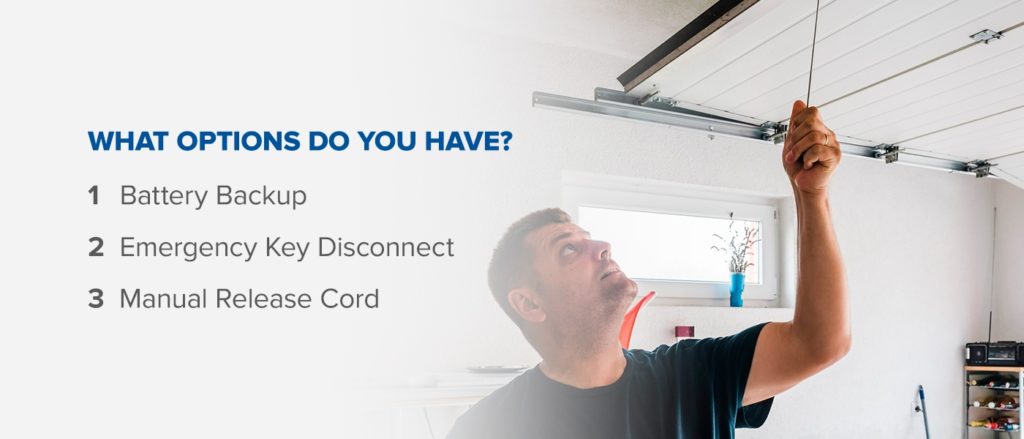How to Open a Garage Door During a Power Outage
We often take automatic garage door openers for granted, especially when they are working as they should. Garage door openers rely on electricity to operate the opening and closing of the door. But will the garage door open if the power is out? Without power to the opener, you may be stuck either inside or outside the garage.
If you’ve experienced this situation, you’re aware of the frustration and inconvenience it can cause. Fortunately, there are a few solutions to this problem, and it is possible to open the garage door when the power is out. In this guide, we’ll cover a few different methods for opening the garage door without power.
What Options Do You Have When There’s No Power?
If the power goes out and you need to open your garage door, do you know what to do? You may have a few different options to fix the problem. However, the best solution for you will depend on the specific brand and model of garage door opener that you have, and what special features are included. It can also depend on the situation you’re in — for example, why the power is out and if the opener is still functioning otherwise. Here are the three most common options for opening a garage door without power:
1. Battery Backup
Some models of automatic garage door openers come equipped with a backup battery. This allows you to open the door with your remote or keypad, even if the power is out in the area. However, this function will likely not work if the opener is broken, malfunctioning or if the battery is dead.
Check your unit’s manual to see if you have this feature and if you should check to make sure the battery backup is charged and ready for an emergency. Note that this feature is often only included if the garage door is the only entrance and exit to the garage, and when there is no other door for people to use.
2. Emergency Key Disconnect
This is another emergency feature that is usually only included if the garage door is the only entrance or exit to the garage. If you have this feature, you’ll see a keyhole lock partway up on the outside of the garage door. You should have a key for this lock, which you can use to open the emergency disconnect.
When unlocked, the unit pulls a cable out that will disengage the lock on the opener motor, so you can manually open your garage door by pushing the door up. This method works during a power outage, and even if the opener is broken or malfunctioning.
3. Manual Release Cord
This feature comes standard with any automatic garage door opener on the market today. With normal functioning, the opener locks your door in the closed position as a safety feature, so someone can’t push the door open at any time. However, in an emergency situation, you can pull the manual release cord to disengage the opener lock, so you can open the door manually.
Using the Manual Release Cord to Open Your Garage Door Without Power
Every garage door opener should have a manual release cord, so this may be the best way to open the garage door in case of an emergency. We’ll cover the basic steps for how to open a garage door manually using the release cord:
1. Make Sure the Door Is Down
Before you attempt to manually move the door, make sure the door is in the down, or closed, position. If the garage door is up or in the open position when you pull the manual release cord, it can be extremely dangerous. This is because it puts all the pressure on the springs. If the springs are broken or damaged when you pull the cord, there is a higher risk of the entire door falling off the tracks and onto whatever is below. If you’re standing below the door, this could result in serious injury, as well as damage to your car and anything else in the garage.
2. Pull the Release Cord
As long as the door is down, you can pull the manual release. You’ll find the manual release cord hanging from the main opener motor unit. This cord is often colored red and may have a T-shaped plastic handle at the end that is easy to grab. Pull the handle on the release cord to unlock the door from the opening mechanism.
3. Manually Move the Door as Needed
At this point, you should be able to safely and easily push the door open. Move the door up and down as many times as needed during the emergency, but be sure to return the door to the closed position when you are done. This is an important step in order to return the cord to a safe position, resume normal function and ensure the release cord is in the right position the next time you need it.
4. Pull the Release Cord Back Towards the Door
This step allows for the trolley to be connected again and for the spring lever to return to the connected position as well. Simply pull on the release cord again, downward and towards the door, away from the motor.
5. Reconnect the Trolley and Opener Carriage
Next, you’ll need to connect the trolley to the opener carriage again, and there are a couple different ways to do this. One method is to manually push the door until the trolley and opener carriage reengage. An even easier method is to push the button on your remote or keypad, and the connection should happen automatically. You should hear a loud click as everything locks back into place. Then, the emergency release cord should be reset and waiting for the next time you need it, and your garage door should be able to function normally.
Garage Door Opener Repair and Maintenance Services
Now that you know how to open a garage door without electricity, you’ll be more prepared for the next power outage or other emergency. If you’re experiencing problems when the power is working and you need garage door opener repair or maintenance, contact Best Overhead Door for service. For nearly 30 years, we’ve been the go-to garage door opener service company for the entire Portland, Oregon, metro area and for Vancouver, Washington. Give us a call at 503-620-1205 or contact us online to schedule your service today.



